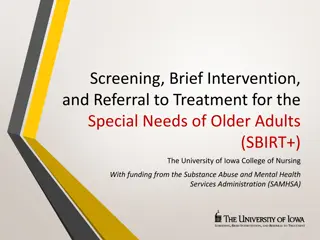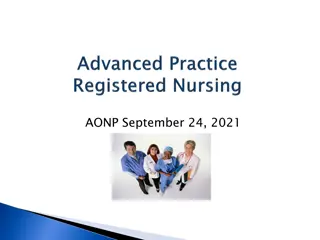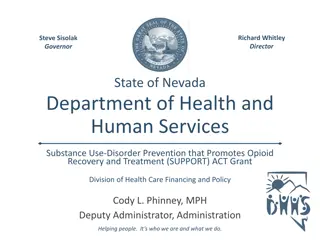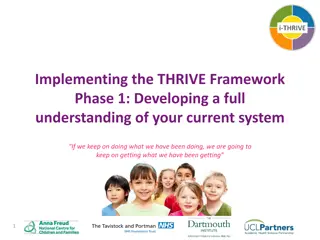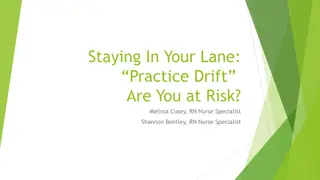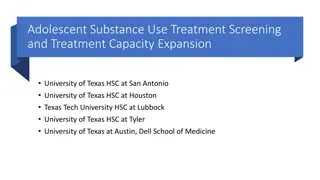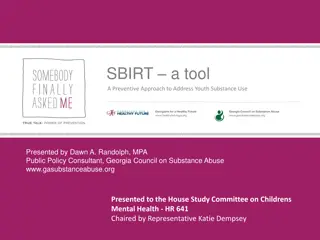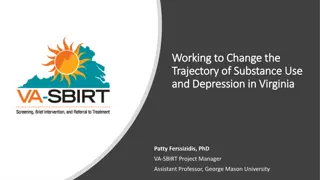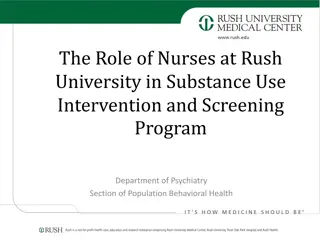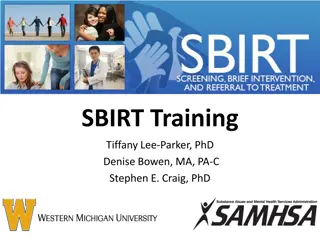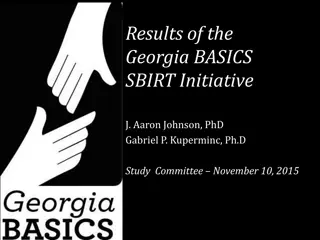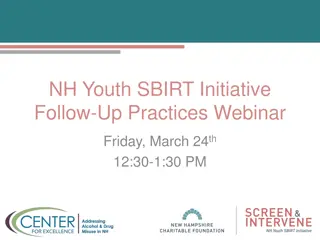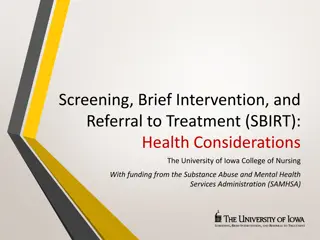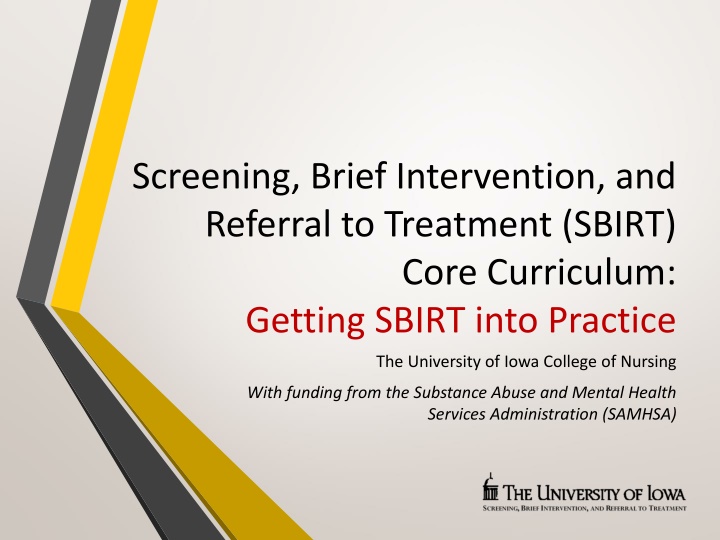
Implementing SBIRT in Clinical Settings: Best Practices and Challenges
Discover the core concepts of SBIRT (Screening, Brief Intervention, and Referral to Treatment) and how to integrate it into healthcare settings effectively. Learn about prescreening results, team-based approaches to screening, implementation challenges, and models for adopting evidence-based practices.
Download Presentation

Please find below an Image/Link to download the presentation.
The content on the website is provided AS IS for your information and personal use only. It may not be sold, licensed, or shared on other websites without obtaining consent from the author. If you encounter any issues during the download, it is possible that the publisher has removed the file from their server.
You are allowed to download the files provided on this website for personal or commercial use, subject to the condition that they are used lawfully. All files are the property of their respective owners.
The content on the website is provided AS IS for your information and personal use only. It may not be sold, licensed, or shared on other websites without obtaining consent from the author.
E N D
Presentation Transcript
Screening, Brief Intervention, and Referral to Treatment (SBIRT) Core Curriculum: Getting SBIRT into Practice The University of Iowa College of Nursing With funding from the Substance Abuse and Mental Health Services Administration (SAMHSA)
SBIRT in Clinical Settings Annual 2-item screen (<1 min), followed by the full screen ONLY if indicated! Full screen (3-5 min) doesn t take much time! Annual 2-Question Prescreen Positive: Negative: Stop Full AUDIT or DAST-10 Education Sheet Low Risk: Positive Reinforcement Risky: Brief Intervention Harmful or Dependent: Brief Intervention Referral
Prescreening Results Based on previous experiences with SBIRT, 75% of prescreens are NEGATIVE Negative About 20% to 25% are POSITIVE, indicating you use the AUDIT, DAST, or both Positive
Screening in a Clinical Setting Most settings use a team approach. Different steps can be done by different individuals and achieve the same outcomes!
Using SBIRT in Practice Like other evidence-based practices Great to know about evidence/success Hard to implement in daily practices!!! Too busy Too much paperwork already Not enough staff to help Not comfortable with substance use discussions
Using SBIRT in Practice Additional concerns: Too much to learn No time to learn new skills (Motivational Interviewing, Brief Intervention) Availability of and access to SBIRT training Workflow issues Sustainability
Models for Adoption of Evidence Lots of models related to changing practice The Iowa Model https://uihc.org/iowa-model-revised-evidence-based-practice-promote- excellence-health-care Strengths-Weaknesses-Opportunities-Threats (SWOT) Analysis http://www.health.state.mn.us/divs/opi/qi/toolbox/swot.html Rapid Cycle Quality Improvement (RCQI) http://www.health.state.mn.us/divs/opi/qi/toolbox/pdsa.html https://www.healthit.gov/providers-professionals/faqs/how-do-i-use-rapid- cycle-improvement-strategy
Theoretical Framework Informing MI Prochaska and DiClemente identified five stages of change: 1. Precontemplation 2. Contemplation 3. Preparation 4. Action 5. Maintenance
SBIRT Model Matrix Systems-Level Implementation of Screening, Brief Intervention, and Referral to Treatment Technical Assistance Publication Series, TAP 33 SAMHSA www.samhsa.gov (free publications)
SBIRT Model Matrix Three main topics that intersect Service delivery: What SBIRT services will be delivered? What risks will be assessed? Implementation model: How will services be provided? Who will provide what services? Settings: What are the unique characteristics (and challenges!) of the program setting or service area? Who is the target population?
Planning Process & Collaborations Assess organizational readiness Motivation for change Perceptions of current functioning, needs for improvement? Institutional resources Adequacy of office space, staffing? Attributes of staff members Confidence in counseling abilities, adaptability? Organizational climate Clarity of mission? Medical Organizational Readiness for Change (MORC), Bohman et al., 2008
Planning Process & Collaborations Involve as many staff members as possible Who are the primary stakeholders? Who has useful skills and experience? Assess what is needed Is it possible to use existing staff to provide SBIRT? What training will they need? Will additional staff be needed? What are the space considerations?
Planning Process & Collaborations Set clear goals What is realistic given resources available? What is a logical starting point? Assign clear roles and responsibilities Who is the logical coordinator? Who can help with specific tasks (billing, EHR)? Develop collaborations and partnerships Other departments in your health system? Agencies or services outside your setting?
Identify the Setting Questions to consider: Who is the target audience? Does the target audience have access to this setting? What are the unique characteristics and challenges? What resources are available? What are the options/opportunities for screening? What are the options for privacy?
Implementation Models In-House Generalist a staff member who is trained to perform SBIRT in addition to usual duties (not a substance use professional) Performs screening, brief intervention (BI); makes referrals to treatment Pros: Recommendations can be tied to other health or medical problems; increases comfort for the person Cons: Competing demands; discomfort with having substance use conversations
Implementation Models Lessons learned: Overcoming barriers to In-House Generalist Implement SBIRT in ways to reduce staff burden Develop strong SBIRT Champions Provide time for buy in activities Provide adequate training and support Collect and share information about outcomes to help staff see how they are helping people
Implementation Models In-House Specialist a person already trained in SBIRT is hired specifically for this role Performs all SBIRT-related activities Pros: Frees regular staff from having to conduct SBIRT- related activities; provides consistency in service Cons: Non-medical specialists may find health setting challenging; turf wars; supervision issues; disagreements on roles
Implementation Models Contracted Specialist an outside provider conducts SBIRT services Performs all SBIRT-related services Pros: Frees regular staff from having to conduct SBIRT; provides consistent quality Cons: Time needed to learn about organizational culture, setting, staff; insurance reimbursement may be a problem
No One Best Way!!! Blended models are commonly used In-house generalist does prescreening and screening; a contracted specialist does the brief intervention and referral Options and choices depend on: Volume of patients seen Accessible community resources No matter which model, many different professionals and paraprofessionals use SBIRT!
Service Components Screening WHO will be screened? Will screening be universal? Will prescreening be used? Will a subset of the population be screened? How will those individuals be identified? What is realistic given resources available? Will screening be done at every visit? At regular intervals?
Service Components Screening WHAT are you screening for? Risky/harmful alcohol use? Illegal drug use? Prescription medication misuse/abuse? Tobacco use?
Service Components Screening HOW will patients be screened? What scales or instruments will be used?* What are the key characteristics of the target population? Age? Literacy level? Cognitive functioning? What percent cannot self-administer? What language(s) do patients understand? Will staff administer? Or patients self-complete? Who will score? Interpret results? *See TAP 33, p. 28, for examples
Service Components Brief Intervention How will the BI be provided? Where and when will BI occur? Onsite? By referral? Who will provide onsite BI? What educational materials will be used? What community resources may be tapped? What training do staff need?
Service Components Referral to Treatment What processes best fit resources and needs of patients and the setting? Who will make the referrals to treatment? What resources are available? Know in advance!!! What processes best support a warm handoff ? What follow-up methods are needed?
Service Components Referral to Treatment Lessons learned Make the referral from your clinic (warm handoff) Talk through transportation issues Consider use of supportive services Peer/mentor health educator support Case management Negotiate dedicated treatment slots for SBIRT patients
Service Components Evaluation plan and records What is the best way to track SBIRT practices for individuals and the system? What are the best ways to easily identify patient level information? Initial screen score(s)? Interventions used? Progress notes? Referrals made? Follow-up activities/outcomes?
Service Components Evaluation plan and records How do staff think SBIRT is working for them? Patients? What is the plan for staff evaluations? Frequency? Type of feedback? Who is involved? What improvements can be made? What is working well/should be continued? What resources are needed to maintain progress?
Reimbursement Billing codes Support for adoption of SBIRT Commercial Insurance CPT 99408: Alcohol and/or substance (other than tobacco) abuse structured screening and brief intervention, 15-30 minutes CPT 99409: Alcohol and/or substance (other than tobacco) abuse structured screening and brief intervention, >30 minutes
Reimbursement Billing codes Support for adoption of SBIRT Medicare G0396: Alcohol and/or substance (other than tobacco) abuse structured screening and brief intervention, 15-30 minutes G0397: Alcohol and/or substance (other than tobacco) abuse structured screening and brief intervention, >30 minutes G0442: Annual alcohol misuse screening, 15 minutes G0443: Brief face-to-face behavioral counseling for alcohol misuse, 15 minutes
Reimbursement Billing codes Support for adoption of SBIRT Medicaid H0049: Alcohol and/or drug screening H0050: Alcohol and/or drug services, brief intervention, per 15 minutes (not currently unlocked in Iowa) Affordable Care Act (2010) includes substance use disorders as one of the ten elements of essential health benefits
Cost Effectiveness Why SBIRT? Cost-benefit analyses suggest Screening and BI for risky alcohol use $43K in future healthcare use for every $10K invested Fewer hospital days Fewer ED visits Meta-analysis of 15 studies of unhealthy alcohol use Cost-saving benefits met or exceeded standard preventive healthcare services like immunizations and colorectal screening
Key Elements of Sustainability Vision: What is the scope, scale of operation, and timeline? How does it fit in the larger community? Results Orientation: What results will be achieved for the target population? What indicators and performance measures will be used to track progress? Financing: What are expected fiscal needs? How can existing resources be best used?
Key Elements of Sustainability Adapting to changing conditions: How will you/your organization stay informed about policy/funding issues? Community support: How will you build partnerships with clients? Community members? Agencies? Funding sources? Champions: Who are key decision-makers? Opinion- leaders? How will you build a broad base of support?
Key Elements of Sustainability Identify internal supports: Who is most likely/best able to support SBIRT as part of the organizational mission? Make a sustainability plan What are your short- and long-term goals? What challenges or barriers need to be addressed? What strategies can be used to obtain needed resources? What are the best methods/approaches to communicate with key partners and stakeholders?
Summary Many factors to consider when implementing SBIRT in practice settings! Setting and target population Implementation models Service components Reimbursement Sustainability Collaborative, stakeholder-informed, process-oriented focus helps!
Additional Resources TAP 31 Implementing Change in Substance Abuse Treatment Programs http://store.samhsa.gov/shin/content//SMA09-4377/SMA09-4377.pdf TAP 33 Systems-Level Implementation of Screening, Brief Intervention, and Referral to Treatment http://store.samhsa.gov/shin/content//SMA13-4741/TAP33.pdf SBIRT: Opportunities for Implementation and Points for Consideration http://www.integration.samhsa.gov/SBIRT_Issue_Brief.pdf
Content in this module is largely based on TAP 33, provided by SAMHSA


